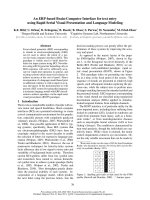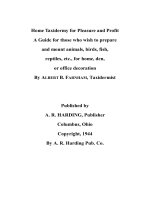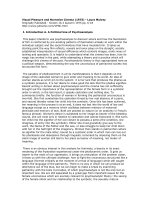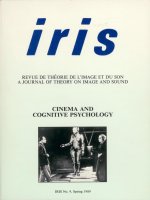laura mulveys article visual pleasure and narrative cinema
Bạn đang xem bản rút gọn của tài liệu. Xem và tải ngay bản đầy đủ của tài liệu tại đây (36.83 KB, 2 trang )
Laura Mulvey's article "Visual Pleasure and Narrative Cinema" argues that in classical hollywood
cinema there exists a different viewing expierience for male and female spectators. explain the
basis of the theory. Do you agree?
Since 1970's Laura Mulvey has been regarded as one of the most famous and well known feminist
in film critic. through out histry, women's body has been used as a vision of pleasure by men.
women's bodies have been used to make profit for the males sexual desire. the women's body itself
becomes an object of desire for a man, and the amount it signifies, is mostly sex. in my essay
today, i will be talking about Laura Mulveys article "Visual Pleasure and Narrative Cinema".
Mulvey builds her critic on mainstream cinema on Freud's and Lucan's psychoanalytic theory, in
which the key component of her arguement is that there is a difference between viewing of male
and female spectatorship in hollywood cinema, where the male is always in the position of
dominant viewer and the female viewer is always viewed as an object on the screen by the males.
the unconcious of the patriachal society that we live in constructs film forms. women can only
exist in relation to castration and her body and her image that she posseses are tied to her place as
a bearer. i will first talk about Laura Mulvey's theory and than will move on and take a stand on
my opinion on her theory. the way i look at Mulveys theory, its divided into two parts. first is
pleasure in looking/ facination with the human form and second is women as image, man as bearer
of the look.
When Mulvey talks about Patriachy and film forms in her article, we can view that her form is
seductively direct. she states that the males visual pleassure, the way they look at women and the
way women are shot, is the controling pleasure in cinema. i totally agree with Laura Mulveys view
of male's visual pleasure being the controling pleasure in cinema and a brilliant example of this
cca be seen in the movie called "Dance Girl Dance". In this movie there are many scenes from
where one can feel that the scenes are generally for the pleasure of the male audience but the best
example is when Bubbles does her Hula dance. Bubbles hula dance is governed typically for the
male audience not only outside the film who will be watching it in the cinema and at homes but
also for the males in the film. the way the camera poses on to Bubbles body parts and her
movements is a good example to proof this point. thus we do see that the gaze in the cinema is
very obvious, which is male. Mulvey says how " the cinema offers a number of possible
pleasures" (page, 59). There are two main components when one engages in viewing hollywood
cinema. The major source of pleasure for the viewers in cinema is called Scopophilia. it means the
pleasure in looking and in being looked at. According to mulvey, women are always looked at and
so are seen as an object which provides pleasure for the male viewer, which we can again see in
many scenes from the movie "Dance Girls Dance". The scopopholia component is also described
by Freud, in Mulveys article as "taking other people as object and subjecting them to a controling
and curious gaze" (page, 59). The pleasure here is a sexual pleasure and so Laura Mulvey
emphasizes that it is an independent of Freud's erotogenic zones. it seems that this component is
also inhereted in children. this can cause a lot of descruption becaue consant image of a person
being an object can cause complications and difficulty. scopophilia at an extreme can
become a perversion such as obsessive voyeurs and peeping toms. while scopophilic pleasure
involves seeing others as an object of sexual stimulation, the second kind of pleasure comes from
identifying with the image, a narcisstic pleasure, which has to do with the constitution or
mantainance of the ego. in this compoent of pleasure, Mulvey uses Lucan's concept of ego
formation and the mirror stage. it can be well explained in the terms of an example of a children.
when children are growing up they they derive narcissistic pleasre from identifying which is to
them the perfect image, the perfect picture of the human figure on the screen. when we think about
this situation, we realize that in both the cases, however, duringthe mirror stage and in the dark
cinema, identification are not in the form of self knowledge or even awareness. they are rather
based on what Lucan calls meconnaissance, which means that the image has effected them so
much that they become totally blind at this point by the narcissistic forces that make them the way
they are at the first place. ego formation is further structured and formed by characteristics of
imaginary functions. both the pleasuring look, scopophilia and narcissistic look requires
idealization and therefore encourages the viewer which in this case are maes to avoid the true
preception of what is been showed. the hollywood cinema combines the two contradictory
functions very well by building up the fantasy world, while discouraging the view of the real
world.
Mulvey further on in her article talks about: women as image, man as bearer of the look. due to
sxual imbalance , pleasure in looking is split between active/ male and passive/ female, which
means the male gaze. mulvey argues that "the ditermining male gaze projects its fatasy on to the
female figure. (page, ). The women displays herself on the screen. again we can see a clear
example from the movie "Dance Girls Dance" where at the end Bubbles has her own show where
she gets paid a lot and where she performs for mostly the male audience dressing seductively and
singing songs to provide thm pleasure and songs that their wives would never sing for them.
Bubble is an objct for the male viewers her and she displays her self on the screen for them. a
females body is put up on the screen for viewing pleasure by the male audience and the male
performers who are in the movie. the function of the female performer is "as erotic object for the
character within the screen story, and as erotic object for the spectator within the auditorium, with
shifting tention between the looks on either side of the screen" (page, ).when this hapens Mulvey
says that the story line of the movie then does not work. "it tends to work against the development
of a story line, to freeze the flow of action in moment of erotic contemplation. its true that the
appearance of women as an object slows the procedure of the film, because the women is put there
for the pleasure of the male's desire and delay in the progression of the film. a good example can
be seen again in the movie "Dance Girls Dance", when Bubbles performs the Hula dance for the
man who is the boss of a club and is there at the girls dorm to hire some one to dance at his club.
Bubble performs a long dance filled with sexy moves and sexy looks. the man is sitting on the
chair infront of her and is occupying the utmost pleassure out of her dance. Bubble with her
flirtiseous dance manages the man to hire her for his club. the way the camera shots in this scene is
purely for the male audience because it slowly focuses on Bubbles body along with the music.
when the man is watching Bubble we can see him sitting on a chair. he does not say any thing but
as he watches we can see that his eyes keep growing out of excitement. as soon as the dance is
over, the boss of the club gets up and is excited to hire Bubble
for his club so she can entertain men in his club. we can see here how mulveys point is true. the
movie did delay the dtory line when Bubbles was dancing and did provide pleasure for the men in
the process.
The above are some of the main points that Laura Mulvey argues in her article 'Visual Pleasure
and Narrative Cinema". She makes very valid points and proves her idea that the males and
females have a different way of viewing the movies in hollywood cinema. the gaze is a male gaze
and so the movies are for the desire and pleasure of the male audience. the women is seen as a
sexual object in the movies and plays a role of being passive. i do agree with most of the points
with Laura Mulveys arguement that there exists a different viewing expirience for both male and
female spectator. i feel that in her arguemnet she forgot to mention or did not think about the
lesbians. the lesbians too get the same pleasre out as the men do in viewing the movie. lesbians are
in between the position of male as a viewer and female position as a female who is shown on the
screen. tey are neither on the active position nor n the passive position. even the gaze for them is
undecided since t is the male gaze even though they are getting pleassure out of the same thing
that men are. they are stuck in between with the males as the viewers and themselfs being a
women. the lesbians here are placed in a very weak position. the rest of the points that Mulvey
argues makes sense and i do agree withthem but viewing of lesbians is the only thing that i think
Mulvey does not include in her arguement. most people might feel that Mulvey's article might be
outdated since things have been moving really fast in hollywood cinema, but even today i say that
things are mostly the same we can see all the components of Mulveys article in most of our
movies in hollywod cinema.









